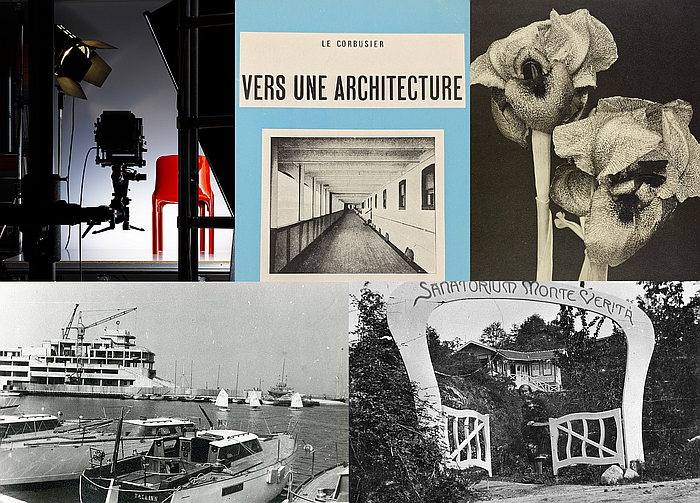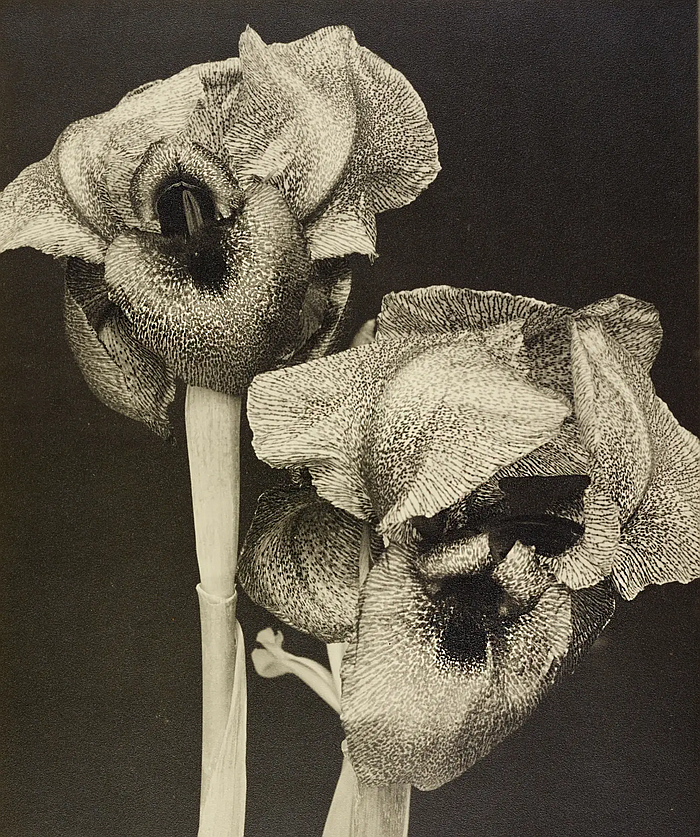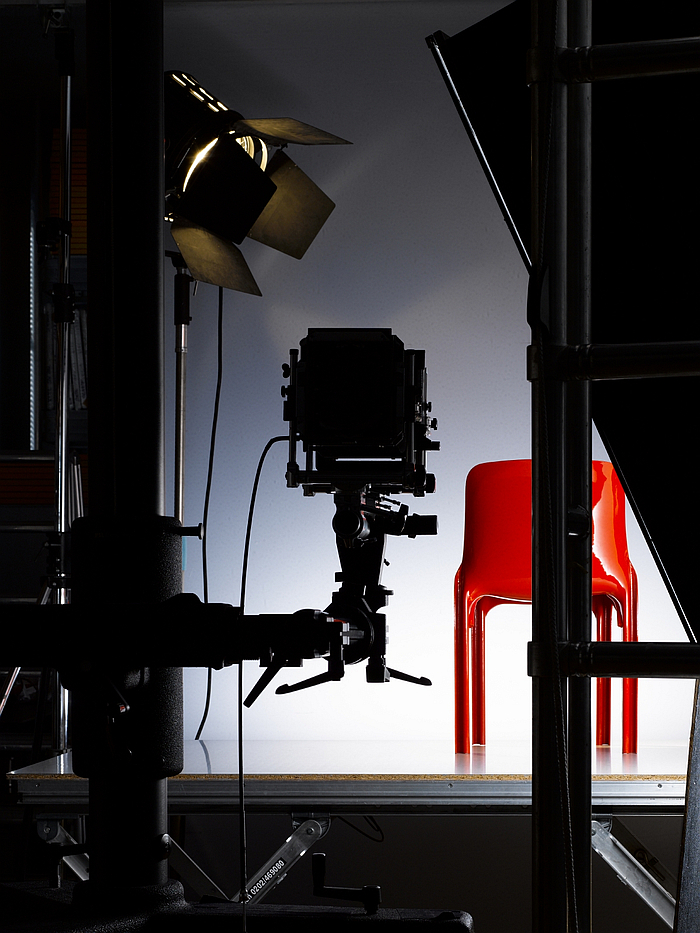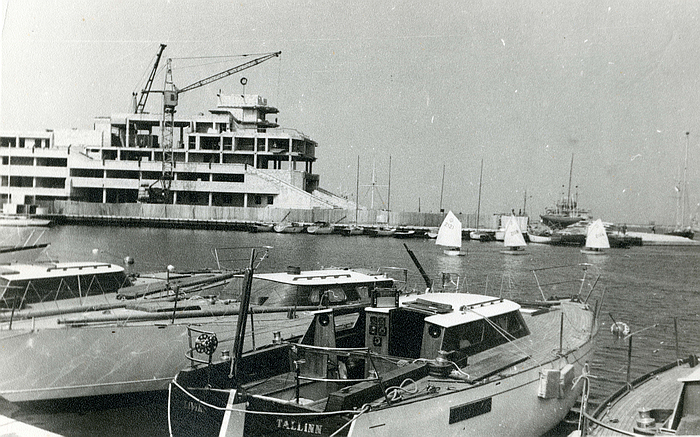That the weather in April is unpleasantly fickle, rarely knows what it wants or how to express itself, makes April the perfect month to concentrate on indoor activities, such as visiting an architecture or design exhibition.
Our recommendations for avoiding the weather, and thereby expanding your horizons, in April 2025 can be found in Dessau, Zürich, Hamburg, Tallinn and Bonn.......

The Bauhauses are often held as impulse-giving for contemporary architecture and design, and an argument can certainly be made that in many regards they were. And still are.
¿But also in terms of the relationships between architecture and design and the environment? ¿In terms of the environmental impact of architecture and design? ¿In terms of the environmental responsibility of architects and designers?
Lest we forget it was 100 years ago, in context of the technology, attitudes and positions of 100 years ago. But also an age informed and influenced by the myriad Reform movement positions of the late 19th/early 20th century.
With Bauhaus Ecologies the Bauhaus Museum, Dessau, seek to explore the relationships between both the Bauhauses as institutions and individual Bauhäusler and the non-human environment, from a variety of varied perspectives including, and amongst others, natural philosophy, biocentrism or crystallography, across a wide range of creative genres, including the more avant-garde artistic practices of the 1920s such as photography and film in their various expressions, but also the long established practice of architecture in context of, for example, considerations on climate-responsive construction methods.
A presentation that thereby should allow one to not only begin to approach differentiated, expanded, perspectives on the (hi)story of the Bauhauses, to move away from the more established Bauhaus gaze, but also to better formulate questions of relationships with, understandings of, the environment in context of wider International Functionalist Modernism of the 1920s and 30s. And how that relates to our age. How far we have actually moved on from the technology, attitudes and positions of 100 years ago.
Bauhaus Ecologies is scheduled to open at the Bauhaus Museum, Mies-van-der-Rohe-Platz 1, 06844 Dessau-Roßlau on Friday April 11th and to run until Sunday November 2nd. Further details can be found at https://bauhaus-dessau.de

In his 1923 book Vers une architecture Le Corbusier published seven essays that reflected his, and arguably Amédée Ozenfant's, positions on and to contemporary, and future, architecture, and the role and function of architecture and the architect. A book that played an important role in establishing Le Corbusier's reputation and which a century after its publication remains a key work in the canon of architectural theory.
By way of celebrating that centenary Pavillon Le Corbusier/Museum für Gestaltung, Zürich, present with Reflections a presentation based around 8 essays by international practitioners of varying hues which aim not only to provide for the reflections of the exhibition's title on Vers une architecture a century later, but also for reflections on Le Corbusier, the work of Le Corbusier, the positions of Le Corbusier, in context of contemporary, and future, society, technology, challenges et al. In context of contemporary, and future, architecture.
And thus a presentation that should not only allow for a more nuanced locating of Le Corbusier and his positions in the (hi)story of architecture, but for all allow a questioning of the validity of Vers une architecture's place in the contemporary canon of architectural theory. To approach the question of in how far Vers une architecture can help us move vers une architecture, towards a (new) architecture.
Vers une architecture: Reflections is scheduled to open at Pavillon Le Corbusier, Höschgasse 8, 8008 Zürich on Friday April 25th and run until Sunday November 23rd. Further details can be found at www.museum-gestaltung.ch

For all that our age is one primarily led by visuals, the power of a strong visual presentation has been appreciated for as long as the camera has, one thinks, for example, of a Luicia Moholy's images of Bauhaus and their use in the 1920s by way of publicising the institution and its objectives.
With Hello Image. The Staging of Things the Museum für Kunst und Gewerbe, Hamburg, aim to focus less on the image as such and rather to take you behind the scenes to explore the cooperations between creatives of various genres that leads to the visual image by which an object introduces itself to us, via which the product is, and always was, sold.
An exploration to be undertaken via 18 examples across 8 chapters featuring projects by designers such as, and amongst many others, Marianne Brandt, Konstantin Grcic, Ettore Sottsass or Issey Miyake, alongside graphic design by the likes of Lora Lamm or Otl Aicher and photos by individuals as diverse as an Olivero Toscani or the aforementioned Lucia Moholy. Or by you and I in context of the promised social media stagings.
And an exploration that in doing such should enable not only differentiated perspectives on the visual image as a transporter of information in context of design industries, as an unquestioned definer of our relationship with objects of daily use, but also enable a more nuanced questioning of the controlled and managed processes that leads to that image and its message. And also what happens when the process slips its control.
Hello Image. The Staging of Things is scheduled to open at the Museum für Kunst und Gewerbe Hamburg, Steintorplatz 20099, Hamburg on Friday April 4th and run until Sunday April 12th 2026. Further details can be found at www.mkg-hamburg.de

While the popular memory of the 1980 Summer Olympics in Moscow may be dominated by the numerous boycotts for political and economic reasons, not least the absence of the USA and China, in Tallinn memories of the 1980 summer games are more physical: embodied as they are in and by the urban planning projects associated with the city's hosting of the 1980 Olympic sailing regatta. A hosting related to the geographic location of Moscow, and Tallinn's location not only in the, then, USSR, but on the coast.
Urban planning projects that aside from the Olympic Yachting Centre at Pirita, and a new, the contemporary, passenger terminal at Tallinn Airport, also saw a major rebuilding of the urban centre of Tallinn, thereby enabling the clearing of some of the war time damage, and a regeneration, to and off the city.
A process, not uninterestingly, not least in context of the 1980 Olympic's importance to Russia, and of Russia's dominance of the USSR, undertaken exclusively by Estonian architects, interior designers and engineers. And an architecture and urban planning project that also expanded to include wider art and design orientated projects.
Forty-five years after the fact the Estonian Museum of Architecture aim to reflect with the exhibition/research project Sailing Forward on what was done, what wasn't done and the consequences of what was/wasn't done and thereby should not only enable interesting insights into architectural and design positions in late 1970s Estonia, but also offer insights into the advantages, and risks, of major international events as drivers of urban planning. In how far the winds such international events supply are conducive to a speedy, and calm, sailing forward. While also enabling a more informed viewing of the contemporary Tallinn.
Sailing Forward. How the 1980 Olympic Regatta Shaped Tallinn is scheduled to open at the Estonian Museum of Architecture, Rotermann Salt Storage, Ahtri 2, 10151 Tallinn on Wednesday April 30th and to run until Sunday September 28th. Further details can be found at www.arhitektuurimuuseum.ee

We've long argued that the various Reform movements of the late 19th/early 20th centuries were the proto-hippies of the 1960s and 70s. The Bundeskunsthalle, Bonn, appear to be close to supporting that position.
Or put another way, with Para-Modernism the Bundeskunsthalle promise an exploration of the striving for alternative forms of life, alternative forms of human interaction, of an alternative form of society from the 1900 of its title until the late 1960s of the hippy.
An exploration that in addition exploring the motivations and origins of the various movements of the period under consideration also promises to approach the more esoteric aspects of the various movements, and the darker race theories often associated with such movements, often associated with esotericism. And also promises to discuss the nudity that is a central feature of all such movements.
An exploration that pleasingly also promises a focus on the Loheland school/community established near Fulda in 1919, a female only institution that most unfairly languishes in the shadow of Bauhaus in the popular view of creative education in the first third of the 20th century. A Bauhaus with a complex relationship with the dignity and independence of the female creative.
An exploration that in addition to the social, political, economic and ecological aspects of the period and the movements of its narrative will also feature cultural aspects of the myriad periods as expressed via art, craft and design.
And thus an exploration that through the comparison of similarities and differences it promises to offer, should enable the approaching of better appreciations of not only the various movements, but also of why after over a century since the rise of the first Reform movements, the human species still longs for alternatives to the contemporary. Why haven't we found our peace with ourselves? Why haven't we found our peace with human society?
Para-Modernism. Life Reform Movements from 1900 onwards is scheduled to open at the Bundeskunsthalle, Helmut-Kohl-Allee 4, 53113 Bonn on Friday April 11th and to run until Sunday August 10th. Further details can be found at www.bundeskunsthalle.de
